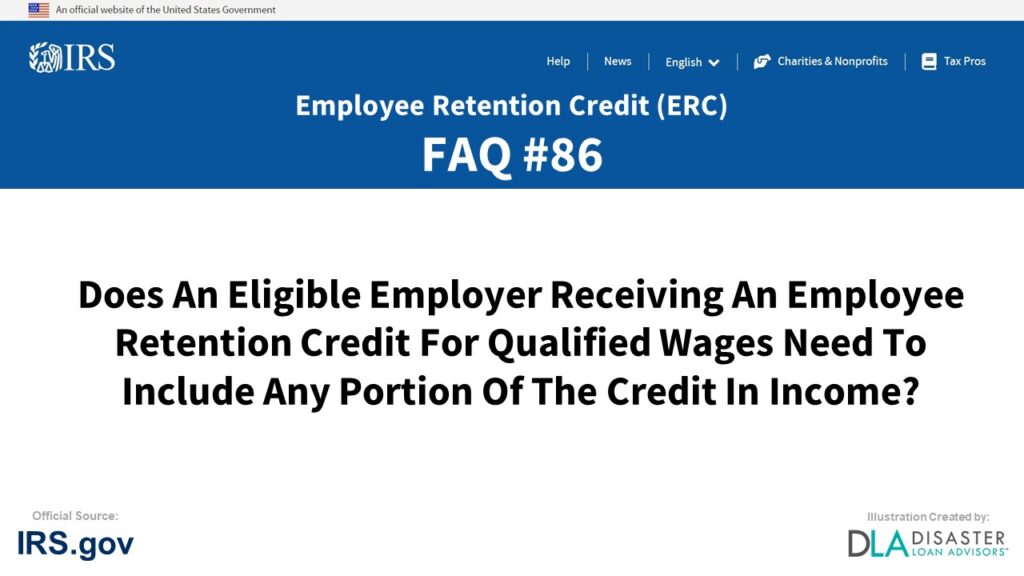
Frequently asked question #86 “Does an Eligible Employer receiving an Employee Retention Credit for qualified wages need to include any portion of the credit in income?” under the Special Issues for Employers: Income and Deduction section of FAQs: Employee Retention Credit under the CARES Act, provided by the IRS.gov to help business owners understand the ERC program. Information is below for the question #86 Does an Eligible Employer receiving an Employee Retention Credit for qualified wages need to include any portion of the credit in income?
ERC Credit Frequently Asked Question #86:
COVID-19-Related Employee Retention Credits:
Special Issues for Employers FAQs
86. Does an Eligible Employer receiving an Employee Retention Credit for qualified wages need to include any portion of the credit in income?
No. An employer receiving a tax credit for qualified wages, including allocable qualified health plan expenses, does not include the credit in gross income for federal income tax purposes.
Neither the portion of the credit that reduces the employer’s applicable employment taxes, nor the refundable portion of the credit, is included in the employer’s gross income.
For more Internal Revenue Service (IRS) Department of the Treasury Employee Retention Credit (ERC) Special Issues for Employers: Income and Deduction FAQs, visit the official IRS.gov tax website.
Conclusion and Summary on ERC Credit FAQ #86. Does an Eligible Employer receiving an Employee Retention Credit for qualified wages need to include any portion of the credit in income?
The “Does an Eligible Employer receiving an Employee Retention Credit for qualified wages need to include any portion of the credit in income?” is Frequently Asked Question #86 of many commonly asked questions small business owners are wondering about how to file the Employee Retention Tax Credit (ERTC). The IRS ERC Tax Credit program is a confusing and complex process to determine the correct ERC calculations your business qualifies for. Answers to “Does an Eligible Employer receiving an Employee Retention Credit for qualified wages need to include any portion of the credit in income?” and filling out form 941-X may change slightly from frequently updated rules and regulations from the IRS. Leave a comment below if you have further questions on ERC Credit FAQ #86.
Help Completing / Filing / Claiming the Employee Retention Credit (ERC)
Receive Up to a $26,000 ERC Credit from the IRS Per Employee
Disaster Loan Advisors can assist your business with the complex and confusing Employee Retention Credit (ERC), Form 941-X, and the Employee Retention Tax Credit (ERTC) program.
Depending on eligibility, business owners and companies can receive up to $26,000 per employee based on the number of W2 employees you had on the payroll in 2020 and 2021.
The ERC / ERTC Tax Credit Program is a valuable IRS tax credit you can claim. This is money you have already paid to the IRS in payroll taxes for your W2 employees.
We DO NOT charge a percentage (%) of your ERC Refund like some companies are charging. Some ERC firms out there are charging upwards of 15% to 35% of your ERC refund!
Our professional ERC fee and pricing structure is very reasonable in comparison.
If you are looking for an ERC Company that believes in providing professional ERC Services and value, in exchange for a fair, reasonable, and ethical fee for the amount of work required, Disaster Loan Advisors is a good fit for you.
Schedule Your Free Employee Retention Credit Consultation to see what amount of employee retention tax credit your company qualifies for.
Cover Image Credit: Irs.gov / ERC FAQ / Disaster Loan Advisors.
